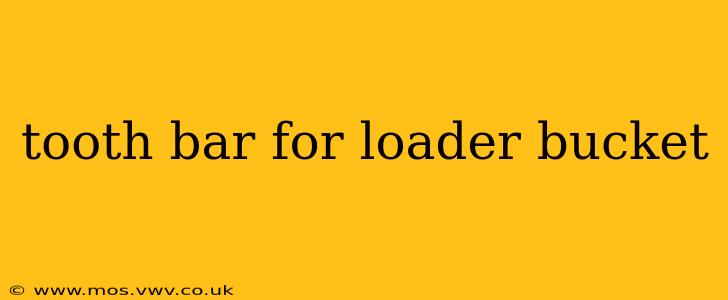A tooth bar for a loader bucket is a crucial piece of equipment that significantly enhances the performance and lifespan of your loader. It's a robust, reinforced steel bar fitted to the cutting edge of your bucket, protecting it from damage and increasing its digging power. This guide will explore everything you need to know about tooth bars, from their benefits to selection and maintenance.
What is a Tooth Bar and How Does it Work?
A tooth bar is a hardened steel bar welded or bolted onto the cutting edge of your loader bucket. These bars are strategically designed with replaceable teeth, which are the primary points of contact with the material being moved. When the bucket digs or scrapes, the teeth bear the brunt of the impact, preventing damage to the bucket itself. The tooth bar acts as a sacrificial element, protecting the more expensive loader bucket from wear and tear.
Why Use a Tooth Bar on Your Loader Bucket?
The benefits of using a tooth bar are numerous and impactful on your operation's efficiency and cost-effectiveness.
-
Increased Durability: The most significant advantage is the protection it provides to your loader bucket. Without a tooth bar, the bucket's cutting edge would sustain considerable damage from impacts with rocks, hard ground, and other tough materials. This damage leads to costly repairs or replacements.
-
Enhanced Digging Power: The teeth on the tooth bar provide superior digging and penetration capabilities compared to a bare bucket. This allows for more efficient material handling, especially in challenging conditions like rocky terrain or frozen ground.
-
Extended Bucket Lifespan: By absorbing the wear and tear, the tooth bar extends the overall service life of your loader bucket, saving you money in the long run. Replacing worn teeth is far cheaper than replacing the entire bucket.
-
Improved Productivity: The increased digging power and durability translate directly into improved productivity. You'll be able to move more material in less time, boosting your overall efficiency.
What Types of Tooth Bars Are Available?
Tooth bars are available in various designs to suit different applications and loader sizes. Factors to consider include:
-
Material: High-strength steel alloys are commonly used for their durability and resistance to wear.
-
Tooth Design: Teeth come in a variety of shapes and sizes, each optimized for specific materials. Some are designed for general-purpose use, while others are specialized for breaking up rock or handling abrasive materials.
-
Mounting: Tooth bars can be welded or bolted onto the bucket. Bolted tooth bars are advantageous for easier replacement of worn teeth.
-
Size and Shape: The dimensions of the tooth bar must precisely match your loader bucket's specifications.
How to Choose the Right Tooth Bar for Your Loader Bucket?
Selecting the appropriate tooth bar depends on several factors:
-
Loader Size and Capacity: The tooth bar must be compatible with your loader's size and lifting capacity.
-
Material Being Handled: Consider the type of material you'll be moving (e.g., dirt, rock, gravel). Different materials require teeth designed to withstand different levels of abrasion and impact.
-
Application: The application (e.g., excavation, landscaping, demolition) will influence the type of tooth bar needed.
-
Budget: While higher-quality tooth bars are more expensive, their extended lifespan often makes them a more cost-effective option in the long run.
How to Install and Maintain a Tooth Bar?
Installation typically involves welding or bolting the tooth bar to the bucket's cutting edge. Precise alignment is essential for optimal performance. Regular maintenance includes:
-
Inspecting Teeth: Regularly check the teeth for wear and damage. Replace worn or broken teeth promptly to maintain efficiency and prevent damage to the tooth bar itself.
-
Cleaning: Keep the tooth bar clean to prevent buildup of debris that can interfere with its performance.
-
Lubrication: Some tooth bars may require lubrication to reduce friction and extend their lifespan.
What are the Common Problems with Tooth Bars?
Common issues include:
-
Broken or Worn Teeth: This is the most frequent problem, easily addressed by replacing the affected teeth.
-
Loose or Cracked Tooth Bar: This indicates a potential structural issue requiring repair or replacement of the entire tooth bar.
How Long Do Tooth Bars Last?
The lifespan of a tooth bar varies significantly depending on usage intensity, material handled, and maintenance practices. However, with proper care, a high-quality tooth bar can provide many years of reliable service.
This comprehensive guide provides essential information regarding tooth bars for loader buckets. Remember to always prioritize safety and follow the manufacturer's instructions when installing and maintaining your equipment.
